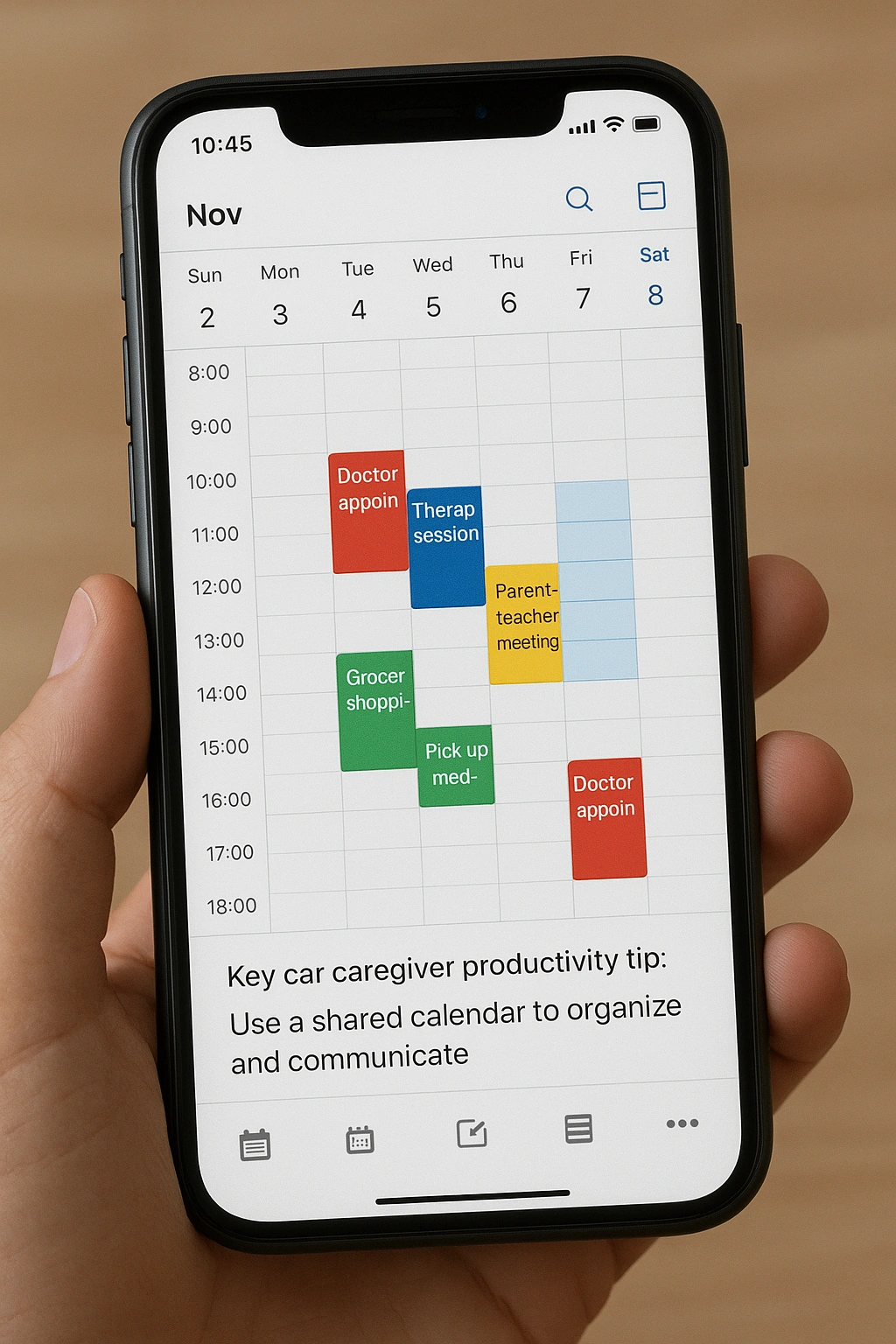
You finish a demanding day at work, and just as your colleagues head home to relax, your “second shift” begins. Finding work life balance in this situation is challenging, but it’s essential for your well-being. For the 1 in 5 employees in the U.S. who are also family caregivers, maintaining work life balance requires planning, support, and realistic expectations. Balancing professional deadlines with personal care duties is difficult, but prioritizing work life balance helps prevent burnout and keeps both your career and caregiving sustainable. By actively seeking work life balance, you can protect your energy, your health, and your ability to care for others without losing yourself in the process.
But achieving a sustainable work life balance is not a myth; it’s a skill that can be developed. This guide is designed for the working caregiver, offering practical strategies to maintain work life balance while managing daily responsibilities. Caregivers will discover actionable tips to improve productivity, communicate effectively, and leverage support, all aimed at strengthening work life balance. After reading, you will have a clear plan to navigate both professional and caregiving roles with less stress and a healthier work life balance.
Redefining “Balance”: What It Means for a Caregiver
For a working caregiver, achieving work life balance isn’t about a perfect 50/50 split. True work life balance is a dynamic, ever-shifting state that adapts to the demands of both your job and caregiving responsibilities. By using strategies and support systems designed for work life balance, you can meet professional obligations while protecting your health, finances, and personal identity. Maintaining work life balance is less about perfection and more about building resilience, ensuring you can thrive in both your career and caregiving role.
The workplace of 2025 is slowly beginning to recognize the “caregiving crisis.” As research from Harvard Business Review highlights, supporting employee caregivers is becoming a business imperative to retain valuable talent. This growing awareness means more employers are open to flexible solutions, making it a critical time for caregivers to understand their options and advocate for their needs.
Why Achieving Balance Isn’t a Luxury, It’s a Necessity
Ignoring the need for balance can have serious consequences for your career, your health, and the very person you’re trying to help. Proactively managing your dual roles is essential for long-term success.
Protecting Your Career and Financial Future
Without effective strategies, caregivers are often forced to reduce hours, turn down promotions, or leave the workforce entirely. This can have devastating long-term financial consequences. A balanced approach allows you to stay engaged and productive at work, protecting your income and retirement savings.
Preventing Burnout and Preserving Your Health
Juggling two demanding roles without support is the fastest route to burnout. Chronic stress compromises your immune system and increases your risk for a host of health problems. A balanced life that includes time for rest is non-negotiable for your physical and mental well-being.
Providing Better, More Focused Care
When you are constantly stressed, distracted, and exhausted, the quality of care you provide inevitably suffers. By managing your stress and protecting your time, you can be more present, patient, and effective when you are with your loved one. As many resources like peternakan.web.id point out, a healthy caregiver is a better caregiver.
The Four Pillars of Work-Life Balance for Caregivers
Achieving balance rests on four key pillars. Strengthening each one will build a more stable and sustainable life structure.

1. Masterful Time Management
This is about being ruthless with your time. Use techniques like time-blocking to dedicate specific hours to work, care tasks, and personal rest. Consolidate errands, automate bill payments, and learn to distinguish between what is truly urgent and what can wait.
2. Open Communication (At Work and Home)
You cannot get the support you need if no one knows you need it. This means having a proactive, professional conversation with your employer about your situation and holding a clear, direct family meeting to delegate responsibilities.
3. Radical Delegation and Support Systems
You are not an army of one. Your mantra must be: “What can someone else do?” This includes asking siblings for specific help, leveraging community resources like meal delivery, and investing in paid help like respite care, even for just a few hours a week.
4. Leveraging Technology
Use technology as your personal assistant. Shared family calendars, medication reminder apps, grocery delivery services, and telehealth appointments are no longer luxuries; they are essential caregiver productivity tools.
Putting It All Together: A Real-Life Scenario
Meet Jessica, a project manager caring for her mother. She felt her work performance was slipping. She took action. First, she had a candid talk with her boss, who agreed to a flexible arrangement where she could work from home two days a week work life balance. Next, she set up a shared Google Calendar for her and her brother, who signed up for all doctor’s appointments. Finally, she used a portion of her salary to hire a companion for her mom for four hours every Saturday, giving herself one protected day to recharge. This multi-pronged approach to work life balance for caregivers saved both her job and her sanity.
Comparing High-Impact Productivity Tools
Here’s a look at some of the best tools to help you reclaim your time.
| Tool/Service | Primary Benefit | Cost | Best For |
|---|---|---|---|
| Shared Digital Calendar | Coordinates family help and appointments. | Free | Organizing help from multiple people. |
| Respite Care | Provides a scheduled, reliable break. | Varies (can be subsidized) | Preventing exhaustion and burnout. |
| Grocery/Meal Delivery | Saves 2-3 hours per week of shopping and cooking. | Subscription/delivery fees | Maximizing time efficiency. |
| Telehealth Appointments | Reduces travel time and waiting rooms. | Covered by most insurance | Managing routine medical check-ups. |
Common Work-Life Balance Mistakes to Avoid
These common errors can sabotage your efforts to find balance. Be on the lookout for them.
- Trying to Keep Your Caregiving a Secret at Work: Hiding your situation creates immense stress and prevents you from accessing support your employer might offer.
- Using All Your Vacation Time for Caregiving: Your paid time off is for your rest and recovery. Using it all for care tasks is a recipe for burnout. Explore FMLA instead.
- Accepting Vague Offers of Help: When a sibling says “Let me know if you need anything,” they mean well, but it puts the burden on you. Respond with, “Thanks, I’ll send you a calendar link with some specific tasks.”
- Blurring Your Boundaries: This includes taking caregiving calls during important work meetings or checking work email while you’re with your loved one. Try to protect your time in each domain.
Expert Tips & Best Practices
Use these powerful, expert-approved strategies to master the juggling act.

- Become an FMLA Expert: “The Family and Medical Leave Act is the single most important piece of legislation for a working caregiver,” notes HR consultant, Maria Flores. “Understand your rights, especially regarding intermittent leave, which lets you take time off in small increments.”
- Propose a Solution, Not Just a Problem: When you talk to your boss, don’t just state that you’re overwhelmed. Present a plan. For example: “I need to take my father to chemo on Wednesdays. I propose working an extra hour on other days to make up for that time.”
- Time-Block Your Personal Life: Schedule “appointments” with yourself for exercise, hobbies, or simple rest, and treat them with the same importance as a work meeting.
- Create a “Caregiving Binder”: Keep all important medical, legal, and financial information in one organized place. This saves frantic searching during an emergency and makes it easier for others to step in and help.
Frequently Asked Questions (FAQ)
Q: How do I talk to my boss about my caregiving responsibilities?
A: Schedule a private meeting and be prepared. Frame the conversation proactively, not as a complaint. Explain your situation, emphasize your commitment to your job, and come with potential solutions, such as a flexible schedule or temporary remote work options. Highlighting how you plan to manage your responsibilities can build trust and lead to a more supportive outcome.
Q: What is the Family and Medical Leave Act (FMLA)?
A: FMLA is a federal law that provides certain employees with up to 12 weeks of unpaid, job-protected leave per year to care for a family member with a serious health condition. It applies to public agencies, schools, and private-sector employers with 50 or more employees. Check with your HR department to see if you qualify.
Q: Is it better to use vacation time or FMLA for caregiving?
A: While it’s tempting to use vacation days for appointments, it’s crucial to save them for actual rest and rejuvenation to prevent burnout. FMLA is designed specifically for these situations and offers job protection. Explore intermittent FMLA, which allows you to take leave in separate blocks of time for recurring needs.
Q: I feel guilty for focusing on my career. Is that normal?
A: Yes, this feeling is incredibly common among working caregivers. It’s often called ‘caregiver guilt.’ It’s important to remember that maintaining your career is a vital part of your own financial security and personal identity. Finding a balance isn’t about choosing one over the other; it’s about integrating both in a sustainable way.
Q: What are some simple tech tools that can help?
A: Shared digital calendars (like Google Calendar) are excellent for coordinating family help. Meal delivery services or grocery delivery apps can save immense time. A digital password manager can help you securely store and share important account information for your loved one.
Conclusion
You are more than a caregiver; you are also a professional, a partner, a friend, and an individual. Achieving work life balance means honoring all of these roles without losing yourself in the process. Maintaining work life balance for caregivers requires setting clear boundaries, communicating your needs, and using available support wisely. By focusing on work life balance, you can be an effective employee, a loving caregiver, and still make time for your own well-being. Practicing work life balance is not a luxury—it’s essential to sustain your energy, your relationships, and your caregiving over the long term.
For more resources on workplace policies, authoritative sources like the U.S. Department of Labor website provide detailed information on FMLA. Your balanced life is achievable, one strategic step at a time.
What is one productivity tip from this guide that you can implement this week? Share your plan in the comments!
